Woody tissues : bark
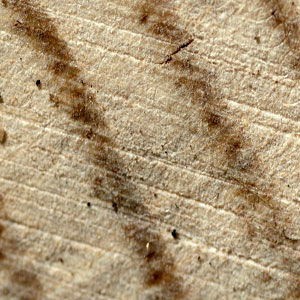
Wood is such a familiar material that we tend to take it for granted. In general, it is a long lasting, fibrous material that is found within the roots, stems and branches of trees and shrubs. It is mainly composed of xylem – a tissue that brings water and minerals up from the roots and distributes the minerals and water to the leaves and growing tissues of the stem.
Xylem also supports and strengthens the plant, allowing shrubs and trees to ‘escape from the herb layer’ up into the atmosphere so that their leaves can intercept the light and absorb carbon dioxide. Usually the xylem forms a central cylinder of tissue. Outside of which lies the phloem (another transport system that carries around sugars and amino acids), and then there is the bark or corky layer.
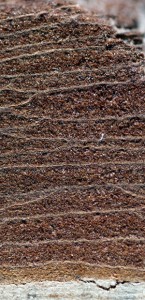 The bark is protective (to a degree); beetles and other insects find it a physical barrier to entry, as do fungi, bacteria and other pathogens or parasites. The bark can be quite thick and multilayered. Like the annual rings that form in the xylem tissue, the layers form when conditions for growth are optimal. Just as a ring of dividing cells forms the xylem and phloem – the vascular cambium, so the bark is formed by another ring of dividing cells – the cork cambium.
The bark is protective (to a degree); beetles and other insects find it a physical barrier to entry, as do fungi, bacteria and other pathogens or parasites. The bark can be quite thick and multilayered. Like the annual rings that form in the xylem tissue, the layers form when conditions for growth are optimal. Just as a ring of dividing cells forms the xylem and phloem – the vascular cambium, so the bark is formed by another ring of dividing cells – the cork cambium. 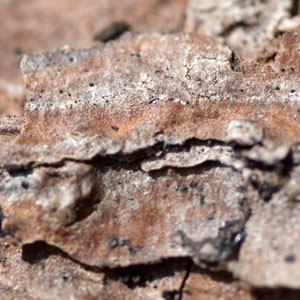 The division of these cells (which are meristematic – divide mitotically) is active when conditions are favorable to growth, but slows right down during the winter months. The adjacent image shows the 'layered' nature of pine bark.
The division of these cells (which are meristematic – divide mitotically) is active when conditions are favorable to growth, but slows right down during the winter months. The adjacent image shows the 'layered' nature of pine bark.
Sometimes the bark is quite 'flaky' as in Scots Pine (see image opposite) or some silver birches; it is generally rough and can provide a surface / substratum for the attachment of epiphytes. Epiphytes are small plants that attach or anchor to a larger plant but take nothing from the larger plant that they are attached to. 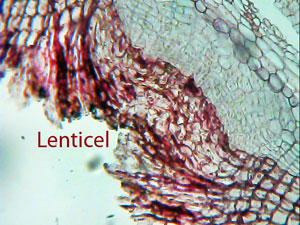 Epiphytes may be lichens, mosses or algae though in tropical and sub-tropical forests certain orchids have an 'epiphytic lifestyle'.
Epiphytes may be lichens, mosses or algae though in tropical and sub-tropical forests certain orchids have an 'epiphytic lifestyle'.
When the bark layer is young and thin, then small spots or slits may be visible; these are lenticels. Lenticels are small fissures or perforations in the structure of the bark where the cells are loosely packed. The lenticels allow for gas exchange to occur, allowing oxygen for respiration to pass in, whilst the carbon dioxide formed can diffuse out.
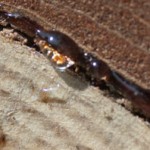 The cells of the cork / bark layer are basically dead but they may contain various chemicals (depending on the species) - such as suberin (a waxy substance), to complex phenolics and tannins - which may have anti-microbial properties. Some barks ooze resinous materials or resins may collect on the cut surfaces of stem (as in the photograph). Resin production increases when trees are under attack by insects such as pine beetles; examination of amber (fossilised resin) confirms that this defence mechanism has been used by trees for millions of years.
The cells of the cork / bark layer are basically dead but they may contain various chemicals (depending on the species) - such as suberin (a waxy substance), to complex phenolics and tannins - which may have anti-microbial properties. Some barks ooze resinous materials or resins may collect on the cut surfaces of stem (as in the photograph). Resin production increases when trees are under attack by insects such as pine beetles; examination of amber (fossilised resin) confirms that this defence mechanism has been used by trees for millions of years.
Comments are closed for this post.
Discussion
Making a cut into the bark of a tree in a circle around the trunk results in the death of the tree? why ?

When you cut through the bark, you also cut / damage the phloem tissue, which lies just underneath the bark. The phloem is responsible for moving sugars and other materials around the tree. For example, sugars made in the leaves are transported down to the roots, using the phloem tissue – so that the root tissues have sugar to be used in respiration. If the conducting channels are cut, then various parts of the tree will be deprived of certain nutrients.
Chris
18 May, 2011